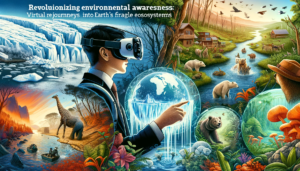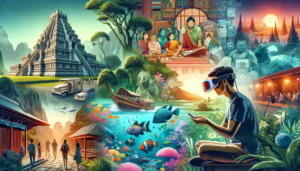Virtual Reality (VR) has revolutionized various industries, and travel is no exception. With the advent of cutting-edge VR technology, individuals can now embark on virtual journeys that mimic the real-world travel experience. This blog post will delve into the exciting realm of virtual reality travel experiences and explore how they are shaping the future of exploration.
1. Introduction to Virtual Reality Travel
Imagine putting on a VR headset and instantly finding yourself standing on the top of Mount Everest or strolling through the bustling streets of Tokyo. Virtual Reality Travel Experiences offer users the opportunity to explore far-off destinations without leaving the comfort of their homes. This section will provide an overview of how VR is transforming the way people perceive and engage with travel.
2. The Rise of Virtual Tourism
As the world becomes more interconnected, the demand for unique and immersive travel experiences is on the rise. Virtual tourism allows users to visit iconic landmarks, historical sites, and exotic locations virtually. We’ll explore the most popular virtual tourism destinations and discuss how this trend is reshaping the travel industry.

3. Virtual Reality and Cultural Immersion
One of the significant advantages of VR travel is its ability to provide users with a sense of cultural immersion. Whether attending a virtual festival or exploring traditional markets, VR technology allows individuals to experience the sights and sounds of different cultures. This section will examine how VR enhances cultural understanding and fosters a global perspective.
4. Overcoming Travel Limitations with VR
Physical limitations, such as health issues or financial constraints, often hinder people from fulfilling their travel dreams. Virtual Reality Travel Experiences offer a solution by providing an inclusive way for everyone to explore the world. We’ll discuss how VR breaks down barriers and makes travel accessible to a broader audience.
5. The Role of VR in Travel Planning
Beyond virtual exploration, VR plays a crucial role in travel planning. Users can preview hotels, check out attractions, and get a feel for destinations before making real-world travel decisions. This section will explore the impact of VR on the travel planning process and how it influences decision-making.
6. Challenges and Future Developments
While VR travel experiences have come a long way, there are still challenges to address. From technical limitations to the need for more diverse content, we’ll discuss the current drawbacks and anticipate future developments in the virtual travel landscape.
7. The Social Aspect of VR Travel
Virtual Reality Travel Experiences aren’t limited to solo adventures. Many platforms allow users to connect with friends or meet new people in a virtual space. This section will explore the social aspect of VR travel and how it is redefining the concept of shared experiences.
8. Case Studies: Successful VR Travel Platforms
Highlighting some of the most successful VR travel platforms, we’ll showcase how companies are leveraging technology to create compelling and realistic virtual travel experiences. Case studies will provide insights into the strategies that contribute to their success.
9. Tips for a Great VR Travel Experience
For those eager to embark on their virtual journeys, this section will offer practical tips for enhancing the VR travel experience. From choosing the right headset to exploring user-generated content, readers will gain valuable insights into making the most out of their virtual adventures.
10. Conclusion: The Future Is Virtual
In conclusion, the blog will summarize the key points discussed and emphasize the transformative potential of Virtual Reality Travel Experiences. As technology continues to advance, the future of exploration looks increasingly virtual, offering endless possibilities for immersive and accessible travel.
